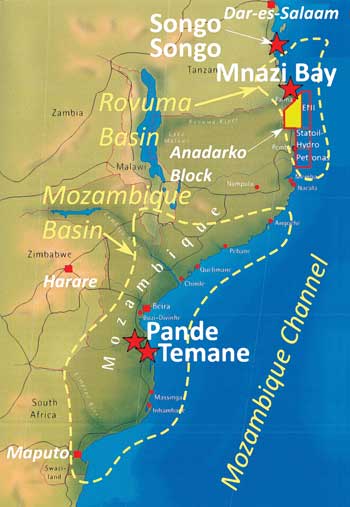What’s new in exploration
Mozambique heats up
Mozambique heats up Exploration activity is heating up in Mozambique as Anadarko prepares to drill its first well before the end of 2009. The company is committed to an eight-well drilling campaign during the next three years. Eni, StatoilHydro, ExxonMobil and Ophir Energy also plan to drill offshore Mozambique and neighboring Tanzania and Madagascar. There are three main petroleum provinces in Mozambique (see map). The Rovuma Basin, where Anadarko’s block is located, is in the northern part of the country, both onshore and offshore, and extends into Tanzania and Kenya. The Mozambique Basin includes most of the southern coastal plain, as well as parts of the continental shelf and slope. The Mozambique Channel consists of several offshore basins between Mozambique and Madagascar. The basins of the East African margin developed in response to the initial rifting of Gondwanaland and subsequent separation of the Madagascar-India-Antarctica plate from Africa. The Karoo Group was deposited from Permian to Middle Jurassic, and consists of reservoir-quality sandstones, and lacustrine to restricted marine shale source rocks. Coastal, marine and deltaic Upper Jurassic and Cretaceous clastic sequences overlie the Karoo and include local carbonate buildups. Principal producing reservoirs are within the Upper Cretaceous to Lower Tertiary Grudja Sandstone. The Tertiary section in these basins includes deltaic and deeper water clastic reservoirs. Most of the petroleum production in the region is gas. There is no production in the Mozambique portion of the Rovuma Basin, but the Mnazi Bay commercial gas discovery was made onshore adjacent to Anadarko’s block in southern Tanzania. It has about 1 Tcf of reserves in Oligocene sandstone reservoirs. The gas consists of methane, and much of it is probably biogenic. Just north of Mnazi Bay in the shallow offshore, Songo Songo Field has gas and condensate reserves of about 500 MMcf. The 1986 discovery, Esso Mocimboa-1, is the only well drilled in the Mozambican part of the basin, and it had gas shows. A number of oil and gas seeps exist in the basin and are believed to come from Jurassic or older sources.
In the Mozambique Basin, Pande, Temane and Inhassoro Fields contain about 4 Tcf of gas and condensate in upper Cretaceous reservoirs. The fields are operated by Sasol, and a 538-mi gas pipeline transports the gas to Secunda in eastern South Africa. Anadarko will target sandstone reservoirs deposited by the Rovuma Delta, one of the few unexplored Tertiary deltaic complexes in the world. Their play consists of a complex linked extensional and contractional fault system with large toe-thrust structures. Deformation probably occurred as a shelf failure along a shale detachment because of sediment loading and tectonic movement. There is a high probability of good-quality reservoir rock in the deltaic and turbidite sandstones, and the structural traps are well-defined by 3D seismic data. The chief technical risks are source and migration. High-quality Permian Middle Jurassic (Karoo) and Upper Jurassic source rocks are very deep on the Anadarko block, having no obvious migration pathway across the thrust detachment into the Tertiary section.
The other risk is commercial, since the structure will probably be charged with dry gas. This outcome would involve a very long pipeline to South Africa due to a limited local market. Without considerable natural gas liquids, I doubt that LNG would be a viable economic option. The most promising area for exploration is for Karoo objectives in the Mozambique Channel along the Davie Fracture Zone (DFZ) in Mozambique, where Eni, StatoilHydro and Petronas have blocks, and also in the portion offshore Madagascar. The Bemolenga and Tsimiroro tar sands in onshore Madagascar contain 25–30 billion barrels of oil that are linked to Karoo source rocks. The Davie Fracture Zone contains many types of large traps including flower structures, tilted fault blocks and salt structures. Wrench-related anticlinal features involve basin inversion, so the thickest reservoirs are within structural closure. Since the tertiary section is very thin or absent on the DFZ, Karoo reservoirs can be reached at acceptable drilling depths of 10,000–15,000 ft. Water depths along the DFZ are 4,500–5,500 ft. Also, evaluation of more than 100 seafloor samples and cores tied to the seismic data have largely eliminated previous concerns that the Davie Fracture Zone was mostly volcanic. Mozambique has the potential to become an important area for petroleum exploration with multiple play types and petroleum systems. The government wants to attract investment and resource development. Important wells will be drilled in the nearly unexplored offshore region soon, and discoveries will almost certainly result. The hope is that new discoveries in Tertiary reservoirs will be richer in condensate than what has been found so far, and that some wells may evaluate more oil-prone plays in the Jurassic and older section. Rusk, Bertagne & Associates and IHS provided information that was used in this evaluation. Their support of this column is greatly appreciated.
|
|||||||||||
- Advancing offshore decarbonization through electrification of FPSOs (March 2024)
- Shale technology: Bayesian variable pressure decline-curve analysis for shale gas wells (March 2024)
- Subsea technology- Corrosion monitoring: From failure to success (February 2024)
- Driving MPD adoption with performance-enhancing technologies (January 2024)
- Digital transformation: A breakthrough year for digitalization in the offshore sector (January 2024)
- Quantum computing and subsurface prediction (January 2024)
- Applying ultra-deep LWD resistivity technology successfully in a SAGD operation (May 2019)
- Adoption of wireless intelligent completions advances (May 2019)
- Majors double down as takeaway crunch eases (April 2019)
- What’s new in well logging and formation evaluation (April 2019)
- Qualification of a 20,000-psi subsea BOP: A collaborative approach (February 2019)
- ConocoPhillips’ Greg Leveille sees rapid trajectory of technical advancement continuing (February 2019)





